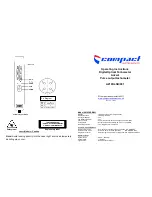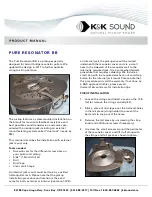
NEP160 User Manual
Copyright
–
2000 - 2011
Specifications subject to change without notice.
Page 12 of 24
F1 Calibration
The probe connected to the NEP160 display unit will determine how the information collected is displayed. But in every
case the mathematical treatment is the same as shown schematically below:
Standard Curve
Algorithm
px
3
+qx
2
+rx
(stored in NEP160
Display Unit
- factory set)
Temperature
Compensation
(NTU/°C)
(stored in NEP160
Display Units
- factory set)
y
L
Probe Calibration
Algorithm
y = bx + c ( 2 point)
y = ax
2
+ bx + c (3 point)
(Stored in probe
- user set)
y
t
Internal Probe
Temperature
Three standard curve algorithms are stored in the NEP160:
1. NEP260 - 90° probe (3,000NTU max)
2. NEP280 - 180° probe (30,000NTU max)
3. NEP900 - Custom probe (custom software)
Data (x)
from
Probe
Result (y)
to display
processing
The probe attached to the NEP160 can be calibrated at any time using a two point or three point technique. When
calibration is complete the time and date of the calibration will also be recorded against the calibration constants.
Probe information including the current calibration constants can be reviewed at anytime.
Calibration Practices
Because a turbidity probe is inherently an optical device, care must be taken during calibration to ensure that external
effects are kept to a minimum. This is best implemented by placing calibration solutions in dark, leakproof bottles with a
non-reflective finish such as Nalgene
®
2106 bottles in amber. These are available with wide necks and a nominal capacity
of 1,000ml.
Another important factor is cleanliness. Any debris or water that makes its
way into the calibration solutions will affect its value and adversely affect
the proper calibration of an instrument. It is therefore a good practice to
have an ample supply of distilled de-ionized water and a means of
properly drying the probe end (clean compressed air is ideal). Probes
should be flushed in two containers of distilled water with thorough
drying in between and before insertion into a calibration solution. Also
calibration should commence at a lower value (usually zero) and work up
in value to further minimize the effects of cross contamination.
Analite turbidity probes are best calibrated using AMCO Clear solutions,
as they are stable and safe. Other solutions may be used such as formazin
but these are normally not as stable and should be treated with caution as
they may contain carcinogens.
When inserting the ANALITE probe into the calibration solution ensure
that the optic face of the probe is at least 50mm from the base and all sides of the bottle. This is particularly important for
low turbidity solutions below 200NTU. Hold the probe a few degrees from the vertical and gently tap it on the bottle rim
so as to dislodge any air bubble on the optic face. If the probe is properly placed the value indicated will not vary if the
probe is gently moved a few millimeters in any direction.










































